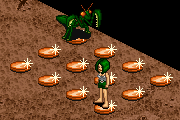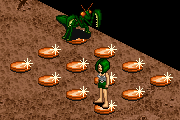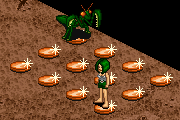

| Beast | Common Beast | Shaman | Rogue | Formation | Aisling | Hunter | Home |
Most creatures you encounter fall in this category. These mindless brutes will charge directly toward their target with no thought of danger. Creatures of this type will always take the shortest route possible to get to the goal. They are very predictable and are easy to guide exactly where you want them to go.
Think of the battlefield as a grid with two axes. There is North and South on one axis. The other axis is East and West. There are two distances between the monster and the target. One is the North/South distance. The other is the East/West Distance. For example, the battlefield marked be coins shown below on the left is 3 paces N/S and 4 paces E/W. The distance between the aisling and the mantis is one (1) on the N/S axis and two (2) on the E/W axis. A simplified grid diagram (below right) will be used to represent the battlefield.


A Common Beast will always move to close the greater of these two distances. In the example, the mantis will move east, since the E/W distance of two (2) is greater than the N/S distance of one (1).


If both distances are the same, as they are now in the example (E/W 1 and N/S 1), the creature could move on either axis. The mantis in the example might move east or south. In either case, the mantis will move into the space marked with a star on its next move because of the new distances involved. (E/W 1 and N/S 0 make it move east, or E/W 0 and N/S 1 make it move south.)


When a wall, tree, another monster, or even an Aisling blocks the Common Beast, the beast will try to move clockwise around the obstacle. For example, a beast wants to move east to get close to its victim, but a tree blocks the way. It instead moves to the north (the creature's left).

The easiest way to take advantage of a Common Beast in melee is to allow the monster to come to you. While it approaches, the hunter can rest and prepare to attack. If you position yourself properly you will be able to start the battle with a flurry of attacks to the side of the creature, which is more vulnerable than the front. Waiting for it to come close also keeps you from wandering into the view of other monsters that might swarm you.
Another trick that helps with Common Beasts is Sidestepping. While fighting a monster, take one step to either side (but not back). The beast will follow, but exposes his vulnerable side. An attack to a creatures side does 150% the damage of a frontal attack. (Attacks to the rear do 200% the damage of a front attack.) Attack a few times until the creature turns and attacks and then sidestep again. Sidestepping is slower than simply slugging it out toe to toe with a creature, but it does give an advantage in a fight where the hunter and prey are near evenly matched.
Read the V formation chapter for more details on using this formation for groups of mixed paths.
Common Beast tactics are hardest on spellcasters, who usually prefer to keep hostile opponents away from them. The best way for a spellcaster to deal with these types of creatures is to block their movement. Trees in the Eastern Woodlands and Undine Fields provide an ideal blockage. Two blocks arranged diagonally to each other will keep a Common Beast from its target indefinitely, if the hunter can get the beast on one side of them, while she takes a position on the opposite side, between the blocks. The figure at the right illustrates the proper formation. The blocks need not be trees or objects. Two aislings standing in formation to block will confound the monster just as completely as a tree.


Be careful using this technique. The beast cannot reach you with physical attacks, but its spells are just as effective as ever, and may even come more frequently than normal.
Read the V formation chapter for more details on using this formation for groups of mixed paths.
The Common Beast is very easy to anticipate. A rogue who understands the way the beast moves will be able to guide it directly to her traps without wasting time or precious mana.
Any rogue can tell you, the simplest way to get a monster onto a trap is to place the trap directly between yourself and the beast, either in a north/south line or an east/west line. Then monster will blunder straight through the traps, not caring that its life is coming closer to the end with each step.
Examine left figure below. If a rogue put a trap in the space marked by the star, the monster will hit that trap, no matter which path it takes. If the rogue stood south of the trap, as in the right figure below, then the monster might hit the trap, but it may step to the west of the rogue, missing the trap altogether. Then the rogue must scramble around in circles to get the beast to trigger the trap. When setting traps, either stand in a straight line with the monster, placing the traps between it and you, or stand on the opposite diagonal of the trap, guaranteeing that the creature triggers it.


A variation of the trick described in Common Beasts At Range uses a little known fact about rogue traps called layering traps. If a rogue sets two traps in the same place, both traps stay active. The first monster in that space will trigger the last trap set. If another beast, or the same one, enters that space again, the earlier trap will go off. Rogues may layer as many traps as they like in the same space.
Now, using the V formation described above in Common Beasts At Range, a rogue gets the monster on the opposite side of the blockage from himself. Then the rogue loads that space with as many traps as are required to kill the creature. Once the traps are set, the rogue steps to the side of the blockage and coaxes the monster around it to the side with the traps. Now all the rogue has to do is get to the safety on the opposite side of the tree. The monster will kill itself walking back and forth over the traps.

Read the V formation chapter for more details on using this formation for groups of mixed paths.
| Home | Previous | Next |